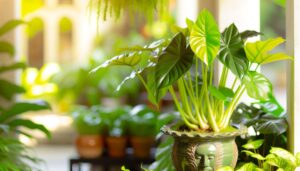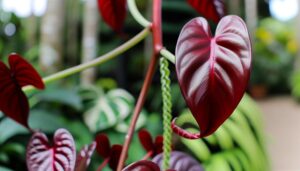What Is Philodendron Bipinnatifidum Gold?
Philodendron bipinnatifidum 'Gold' is a cultivar originating from South America's tropical rainforests, particularly in Brazil and Paraguay. Belonging to the Araceae family, it features vibrant yellow to chartreuse, pinnately lobed leaves that transform in color as they mature.
Its unique coloration results from genetic variation affecting chlorophyll production. This plant thrives in bright, indirect light with temperatures between 18-24°C and requires well-draining soil.
It is essential to provide consistent moisture levels while avoiding waterlogging. Proper care and environmental conditions are pivotal to maintaining its health and unique appearance.
For more detailed insights, continue with the provided information.
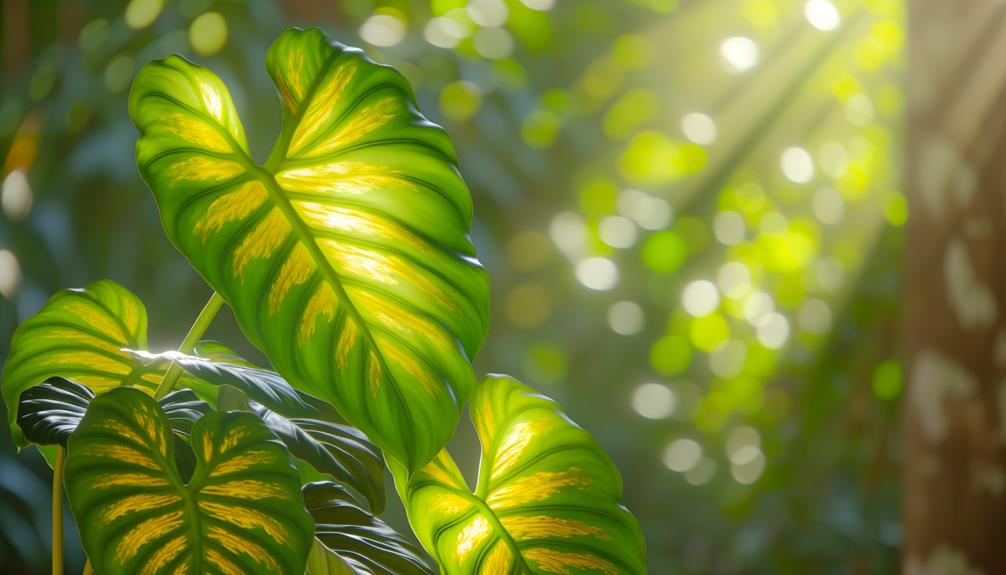
Key Takeaways
- Philodendron bipinnatifidum 'Gold' is a tropical plant with vibrant yellow to chartreuse foliage.
- It features large, deeply lobed leaves and belongs to the Araceae family.
- Originates from South American rainforests, particularly Brazil and Paraguay.
- Thrives in bright, indirect light with consistent moisture and well-draining soil.
- Popular among indoor gardeners for its striking appearance and low maintenance requirements.
Origin and History

Philodendron bipinnatifidum 'Gold', a cultivar of the species Philodendron bipinnatifidum, traces its origin to the tropical rainforests of South America, mainly in Brazil and Paraguay. This plant belongs to the Araceae family, a group renowned for its diverse and often large-leafed members.
The species was first documented by European botanists in the 19th century, who marveled at its adaptability to various light conditions and high humidity. The cultivar 'Gold' was developed through selective breeding to emphasize its striking yellow foliage.
Its introduction to horticulture has made it a favorite among plant enthusiasts and indoor gardeners. The plant's historical and geographical roots underscore its resilience and aesthetic appeal, marking its significance in botanical studies and commercial cultivation.
Unique Characteristics
The cultivar 'Gold' displays a distinctive array of morphological and physiological characteristics, especially its vibrant yellow to chartreuse foliage, which sets it apart from the usual green leaves of its parent species, Philodendron bipinnatifidum.
The leaves of Philodendron bipinnatifidum 'Gold' are pinnately lobed, creating a striking and decorative appearance. This cultivar's foliage goes through a color transformation as it matures, starting with a bright yellow shade and progressively deepening to a lush chartreuse. Additionally, 'Gold' retains the characteristic large, deeply lobed leaves and sturdy petioles typical of Philodendron bipinnatifidum.
Its distinct coloration arises from a genetic variation affecting chlorophyll production, which impacts its photosynthetic efficiency and light needs. The glossy texture of the leaves helps in minimizing water loss.
Ideal Growing Conditions
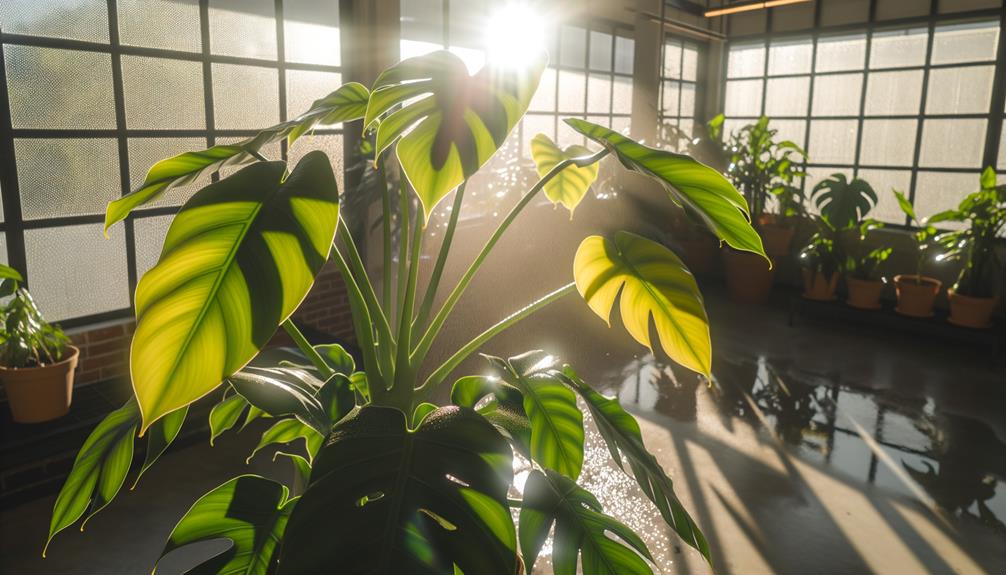
Philodendron Bipinnatifidum Gold thrives in environments with bright, indirect light and temperatures ranging between 18-24°C.
Best growth is achieved with a well-draining soil mix high in organic matter and consistent moisture levels, avoiding waterlogged conditions.
Understanding its specific light, temperature, watering, and soil requirements is essential for maintaining its distinctive foliage and overall health.
Light and Temperature Needs
Understanding the best light and temperature conditions for Thaumatophyllum bipinnatifidum 'Gold' is vital for ensuring its strong growth and colorful foliage. This cultivar thrives in bright, indirect light, which facilitates ideal photosynthesis without causing leaf burn. Direct sunlight should be avoided as it can harm the delicate leaves.
The ideal temperature range for Thaumatophyllum bipinnatifidum 'Gold' is between 18°C to 24°C (65°F to 75°F). It is essential to maintain a consistent temperature, avoiding fluctuations that can stress the plant. Cold drafts and temperatures below 15°C (59°F) should be avoided, as they can hinder growth and cause foliage damage.
Maintaining these specific light and temperature conditions will promote robust growth and vibrant coloration in your Thaumatophyllum bipinnatifidum 'Gold'.
Watering and Soil Mix
Ensuring best hydration and selecting a suitable soil mix are critical components for cultivating Thaumatophyllum bipinnatifidum 'Gold' under ideal growing conditions. This species thrives with consistent moisture but avoids waterlogging. It is advisable to water when the top inch of the substrate feels dry, ensuring even moisture distribution.
Optimal soil composition includes a well-draining mix comprising peat moss, perlite, and pine bark in a 2:1:1 ratio, enhancing aeration and preventing root rot. The pH range should be slightly acidic to neutral (5.5-7.0), facilitating nutrient uptake. Utilizing containers with adequate drainage holes is imperative to mitigate excess water accumulation.
Regularly monitoring soil moisture levels and adjusting watering frequency based on environmental conditions are integral to maintaining plant health.
Care Tips
Proper care of Philodendron bipinnatifidum 'Gold' requires a thorough understanding of its light and watering needs, along with the suitable methods for trimming and repotting.
Best growth is attained by providing the plant with indirect, bright light, and keeping the soil consistently moist without overwatering.
Trimming should be done to eliminate any dead or injured leaves, while repotting is advised when the root system exceeds the current pot, usually every 2-3 years.
Light and Watering
Philodendron bipinnatifidum 'Gold' needs indirect, bright light to mimic its natural understory habitat, guaranteeing ideal photosynthesis without leaf scorch. Excessive direct sunlight can cause chlorosis and necrosis on the foliage. Optimal light conditions involve placing the plant near an east or north-facing window, filtered through sheer curtains.
Watering should be consistent yet cautious; the substrate must remain moist but not waterlogged. Utilize well-draining soil to prevent water stagnation, which could lead to root rot (Pythium spp.). Irrigation frequency varies with ambient temperature and humidity, typically requiring watering when the top inch of soil feels dry. Employ tepid, dechlorinated water to avoid chemical stress.
Monitoring environmental humidity, maintaining levels above 50%, ensures strong growth and health.
Pruning and Repotting
Maintaining the structural integrity and aesthetic appeal of Philodendron bipinnatifidum 'Gold' requires regular pruning to remove senescent leaves and promote vigorous growth, while repotting every 2-3 years guarantees adequate root space and nutrient availability.
Pruning should be conducted using sterilized pruning shears to prevent pathogen transmission; focus on excising yellowed or damaged foliage near the base. This encourages new growth and maintains the plant's ornamental value.
For repotting, select a container that is one size larger, ensuring proper drainage. Utilize a well-draining potting mix rich in organic matter. Gently tease the roots to facilitate expansion in the new substrate. Repotting should ideally occur during the growing season to minimize stress and enhance root establishment.
Common Issues
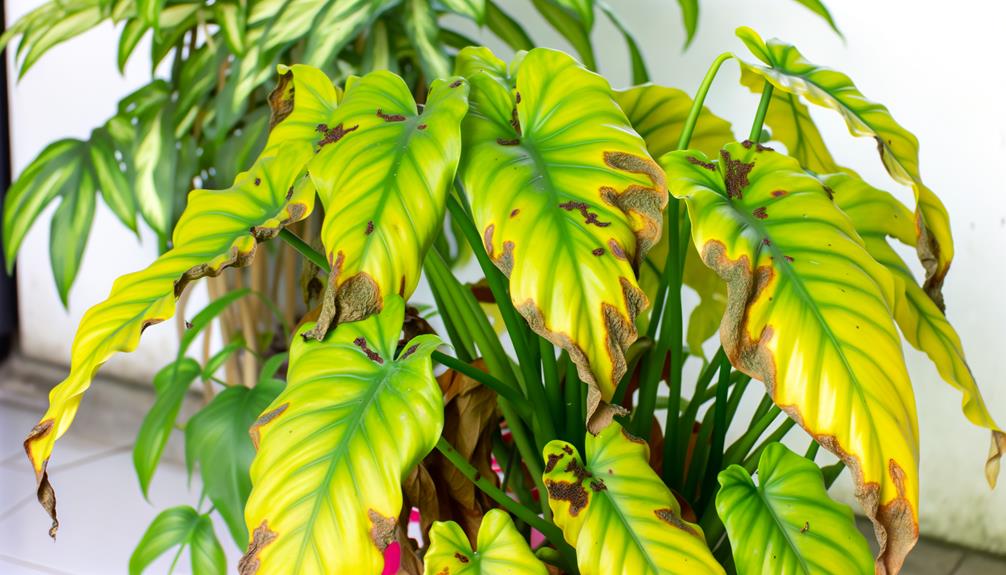
Despite its resilience, Philodendron bipinnatifidum 'Gold' can occasionally encounter issues such as chlorosis, root rot, and pest infestations. Chlorosis, characterized by yellowing leaves, often results from nutrient deficiencies or improper light conditions. Iron (Fe) and magnesium (Mg) deficiencies frequently cause this phenomenon.
Root rot, caused by overwatering and poor soil drainage, leads to blackened, mushy roots and wilting foliage. Effective drainage and appropriate watering schedules are crucial preventive measures.
Pest infestations, including aphids (Aphidoidea), spider mites (Tetranychidae), and mealybugs (Pseudococcidae), can hinder plant health by feeding on sap and transmitting diseases. Regular inspection and prompt treatment with insecticidal soap or neem oil can mitigate these issues.
Addressing these problems early ensures optimal plant health and aesthetic appeal.
Benefits
Cultivating Philodendron bipinnatifidum 'Gold' offers numerous advantages. One benefit is enhanced air quality through the absorption of volatile organic compounds (VOCs), such as formaldehyde and benzene. This promotes a healthier indoor atmosphere. Another advantage is the plant's increased aesthetic value. Its striking foliage features deeply lobed, bipinnatifid leaves with a distinctive golden hue, creating a visually appealing environment. The tropical plant's robust growth habit makes it a durable choice for both indoor and outdoor settings.
Key benefits include:
- Air Purification: Philodendron bipinnatifidum 'Gold' effectively absorbs VOCs, promoting a healthier indoor atmosphere.
- Aesthetic Appeal: The vibrant, golden foliage of this plant serves as an eye-catching centerpiece in any botanical arrangement.
- Low Maintenance: This plant requires minimal care, thriving in a range of light conditions and tolerating occasional neglect. This makes it an ideal choice for busy individuals.
Conclusion
Philodendron bipinnatifidum 'Gold,' distinguished by its vibrant yellow-green foliage, is an appealing cultivar with roots in tropical South America.
It thrives in indirect light and well-draining soil, requiring regular watering to maintain its lush appearance. Proper care mitigates issues like root rot and pest infestations.
Significantly, the American Society for Horticultural Science reports that this species can improve indoor air quality by removing volatile organic compounds, making it both an aesthetic and functional addition to indoor spaces.



